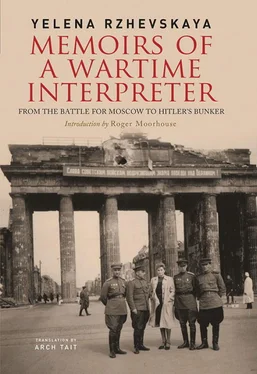Looking around, Käthe saw me sitting on the sidelines. She came straight over and sat down next to me. Without a moment’s hesitation we began talking to each other. Käthe Heusermann was thirty-five. She told me her fiancé was a teacher and now, as a non-commissioned officer, was somewhere in Norway and she had heard nothing from him for a long time. Dr Blaschke had invited her to be evacuated with him to Berchtesgaden, but she refused. She had been working for Blaschke since 1937, and last saw Hitler in mid-April in the Reich Chancellery when she was receiving a ration of cigarettes. With the permission of Magda Goebbels she had left the Reich Chancellery, but continued to go there for rations, which she shared with Dr Bruck.
On 2 May she had heard from strangers in Pariserstrasse that Hitler was dead and that he had been cremated. Later she told me a few details about him and the Goebbels family. It was from her I heard that Magda Goebbels had not been happily married; she complained about her husband’s infidelities and had wanted to leave him, only the Führer insisted on her keeping together their exemplary German family. She quite liked Magda, or at least sympathized with her.
Back then, though, in Dr Blaschke’s surgery, Colonel Gorbushin asked me to ask her whether they had Hitler’s dental records. Heusermann said they had, and immediately took out a box with record cards. We watched with bated breath as she flicked through them. We glimpsed the cards of Himmler, Ley, the press chief Dietrich, Goebbels, his wife, all their children…
The silence was so heavy that we clearly heard in Dr Bruck’s sigh, although he did not know what had brought us there, how anxious he was that everything should turn out well. The student, who by now evidently had a fair idea of what was going on, found our tense anticipation contagious and stood motionless, his head tilted a little to one side.
At last Hitler’s medical card was found, and that was a start, but there were no X–rays. Heusermann suggested they might be in Blaschke’s other surgery – in the Reich Chancellery itself. We said goodbye to Dr Bruck and the student and rushed back there with Käthe Heusermann.
From that day I heard no more about the Bulgarian student until, almost twenty years later, when interest was again stirred up in the question of whether Hitler was dead or alive, because the issue of statutory limitation of criminal responsibility was being debated. At that time, it was set at twenty years. I saw a portrait of this man in Stern. His hair was still wavy and his features soft, although naturally after so much time he had changed. I read that he was Mihail Arnaudov, who lived in Kiel, and I read his interview, which reverberated around the globe, in which he tells truthfully, if in his own way, about our visit, but then adds a fictitious account of his participation in the identification of Hitler.
He had rendered us a great service in taking us from Eicken to Blaschke’s surgery, but had contributed nothing to the actual identification, because we had thanked him and then seen no more of him.
During the time the student was with us, he could easily have worked out why we so needed to track down Hitler’s dentists and his dental history. But then, just when this unexpected, titillating adventure into which the young man had been plunged was approaching its culmination, the curtain had fallen and the actors were lost to view.
On the way to the Reich Chancellery, Käthe Heusermann told me she used to travel with Blaschke to Berchtesgaden, where her patient was Eva Braun. In Berlin the existence of Hitler’s mistress was meticulously concealed until the very last days; there were constant statements to the effect that the Führer did not smoke, did not drink, held aloof from earthly gratifications and devoted himself only to serving the people. That was the cornerstone of all the propaganda.
We parked the car and the three of us walked in silence down the as yet uncleared, deserted Wilhelmstrasse. On a round advertising pillar there was pasted the order of the Soviet commandant of Berlin, General Berzarin, printed on orange paper.
Once more the Reich Chancellery, pockmarked by shells and bullets, blackened with soot, its walls breached in places, a long, straggling building with a single balcony, its architecture an expression of the ‘single will of Germany’ which, in the person of the Führer, would appear on the balcony during Nazi celebrations. Above the entrance, in bas-relief, was the Nazi emblem: a spreadeagle clutching a swastika in its talons. Within a few days this bronze had been hacked down and transported to Moscow, to the Armed Forces Museum, where it can be seen to this day. The sentry did ground his rifle, but barred our way – he had been ordered not to let anyone pass without a special permit from the commandant of Berlin.
Gorbushin whipped out his pistol and pushed the sentry aside. The man was taken aback: he would have had every right to shoot. But we needed to get in.
We opened the heavy oak door. To the right was the assembly hall: the door had been torn off its hinges, chandeliers had fallen to the floor. To the left was the gentle descent to the bomb shelter. Hitler had worked here until 21 April, when our artillery fired a volley of shells into the centre of Berlin and he moved to the Führerbunker.
We passed through the vaulted vestibule and down two flights of stairs, with one dim torch between the three of us. It was dark, deserted and spooky. In the radio studio from which Goebbels broadcast, a Red Army soldier was sleeping with his helmet slipped down over his ear. Only Käthe could find her way around in this Tomb of the Pharaohs. She led us to a boxy little room which, until recently, had been at the disposal of her boss, Dr Blaschke.
The pocket torch faintly picked out in the darkness a dentist’s chair, a couch with an adjustable headrest, and a small desk. There was something on the floor. We picked it up and shone the torch on it. A photo. Käthe recognized the Führer’s deceased Alsatian being taken for a walk by his adjutant. It was damp and there was a musty smell.
We searched through a box with a card index, looked in the desk and a locker. With Heusermann’s help we found the X-rays of Hitler’s teeth and his dental records. We were lucky, incredibly lucky, that the hurricane which had blown through the underground complex a few days ago had left this nook untouched. We found gold crowns which, according to Käthe, had been made for Hitler although, as she admitted in her memoirs written many years later, here she was slightly overdoing it: the crowns were in fact for one of the secretaries. She was understandably anxious to stay on the right side of us. Fortunately those crowns did not figure again in the investigation.
Suddenly, from the depths of the corridor, we heard, ‘By the Vol-ga – a stone …’ It was a lonely voice. Some partying soldier was quaffing expensive wines the German generals that he had sent packing had been drinking as they sought to banish despair. The soldier must surely have been written off by his unit, while here he was consoling himself for a seventh day, sleeping, waking, drinking to the glory of Russian arms and the repose of those who never made it to the Reich Chancellery.
We left, taking with us our incredibly important finds, the most miraculous, the most wonderful of which was Käthe Heusermann herself. Through the empty underground corridors a woozy voice echoed, intoxicated by wine, victory and grief: ‘Someone wai-ting alone …’
No sooner had we got into the car than the engine conked out. Driver Sergey lifted the bonnet. We alighted, and found ourselves right at the Brandenburg Gate. I pictured Nazi detachments with flaming torches marching through the six columns of the gate to the Kaiserhof Hotel, where Hitler usually stayed when in Berlin before he came to power. On the hotel balcony the puny figure of Goebbels would try to make himself seen behind the burly backs of his comrades-in-arms. Hitler would raise an arm in salute over the crowd. The torches of future conflagrations, destruction and book burnings flickered, lit by the Nazis and destined ultimately to consume them. It seemed fitting that ‘torchers’ was the name given in the German Army to soldiers whose job it was to set fire to towns and villages as they retreated.
Читать дальше











